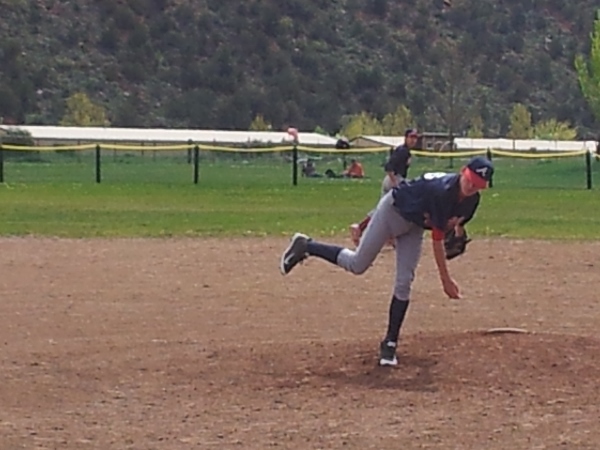Widgetized Section
Go to Admin » Appearance » Widgets » and move Gabfire Widget: Social into that MastheadOverlay zone
Ask a Sports Medicine Doc: pitching injuries in little league baseball

Young baseball pitchers should be limited in both the number and type of pitches they throw (David O. Williams photo).
Q: With baseball season upon us, I received a question from a local baseball coach asking me to explain what happens inside the shoulder and elbow during pitching.
A: The baseball pitch has been extensively studied and can be divided into five main stages. In stage 1 or windup, the elbow is flexed and the shoulder is in slight internal rotation and muscular activity is low. Stage 2, or early cocking, begins when the ball leaves the nondominant gloved hand and ends when the forward foot contacts the ground. The shoulder begins to abduct and externally rotate. This stage activates the deltoid and rotator cuff musculature. Stage 3, or late cocking, entails further shoulder abduction and maximal external rotation. Muscle contraction of the rotator cuff muscles reaches their peak during this phase and muscles around the scapula are activated. Tremendous shear forces are generated across the front of the shoulder in this phase. In stage 4, or acceleration, the shoulder muscles generate a large forward force on the arm, resulting in internal rotation and adduction of the humerus as well as rapid elbow extension. Stage 4 ends with the release of the baseball with there being huge valgus stresses along the medial side or inside of the elbow. Most elbow injuries occur during this phase. In stage 5, or follow through, all excess energy is dissipated as the arm decelerates rapidly. In this stage the elbow comes into full extension and the shoulder is maximally internally rotated. The shoulder muscles are contracting to try to keep the humeral head or ball in the socket.
With nearly 200,000 little league teams in this country, there is a rising number of injuries seen in these young athletes, particularly with some young athletes throwing year round. Most of the injuries that occur in throwing athletes involve the shoulder and elbow joints. Moreover, the repetitive stresses placed on joints by pitching can actually alter the developmental anatomy of the shoulder and elbow over time in adolescent throwing athletes. With years of repetitive throwing in players who are still developing there can be a gradual increase in the amount the shoulder rotates outward with an associated loss of shoulder internal rotation. Coaches and parents should look for loss of shoulder internal rotation in young throwing athletes. If discovered, these athletes should do therapy exercises to correct this.
As for the shoulder, the most common injury seen in young throwers are injuries to growth plate at the top of the humerus. These athletes present with diffuse shoulder pain that is worse with throwing. There may have been an increase in throwing frequency prior to the onset of symptoms. Treatment includes 2-3 months of no throwing followed by a progressive throwing program with attention to throwing mechanics and an emphasis on control not speed.
Elbow injuries actually occur more frequently than shoulder injuries in adolescent baseball players. These injuries usually occur as a result of repetitive stresses. There is tension overload of the medial structures of the elbow with resultant inflammation of the growth plate on the inside of the elbow. Young throwers usually report elbow pain on the inside of their elbow, decreased throwing effectiveness, and decreased throwing distance. There can also be compression injuries on the outside of the elbow in young throwers. Patients have dull pain, swelling, and possible locking and catching in the elbow joint. Again, treatment in these young athletes usually consists of rest from throwing until symptom free and then a gradual return to throwing.
In order to decrease the stresses of throwing in young athletes, coaches should limit the number of pitches thrown. USA Baseball Medical and Safety Advisory Committee has a simple table that can be followed outlining the number of pitches a young pitcher should throw. Furthermore, young pitchers should avoid throwing sliders or curveballs until they are done growing and should also avoid year round baseball. Young pitchers should have a minimum of 2-3 months of complete rest from throwing per year. Furthermore, it is a common misperception among coaches and parents that pain in the shoulder or elbow during baseball is a result of weak muscles that need to be strengthened. Instead, joint pain when throwing should be regarded as a potential injury.
Dr. Rick Cunningham is a Knee and Shoulder Sports Medicine Specialist with Vail-Summit Orthopaedics. He is a Physician for the US Ski Team and Chief of Surgery at Vail Valley Medical Center. Do you have a sports medicine question you’d like him to answer in this column? Visit his website at www.vailknee.com to submit your topic idea. For more information about Vail-Summit Orthopaedics, visit www.vsortho.com.
Latest posts by Dr. Rick Cunningham (see all)
- Dr. Rick Cunningham: Save your ACL - January 7, 2018
- Ask a Sports Medicine Doc: MOON study on ACL reconstruction - March 20, 2015
- Ask a Sports Medicine Doc: Calcific tendonitis of the rotator cuff - December 3, 2014



